INDEX
- English
- 日本語
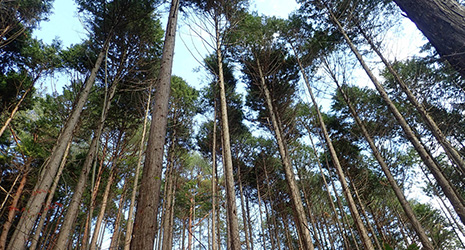
A cypress forest in Maniwa City - English
- 日本語

Public restrooms in Maniwa City made from Cross Laminated Timber (CLT)
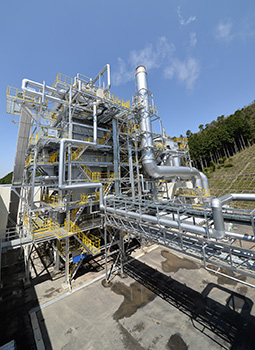
Maniwa Biomass Plant 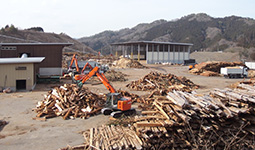
Maniwa Biomass Collection Center 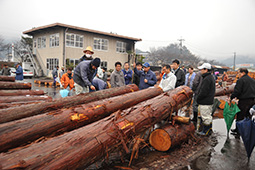
The timber market in Maniwa 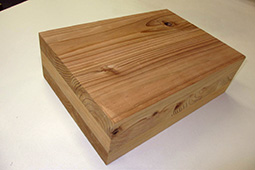
A block of Cross Laminated Timber (CLT)—planks of wood glued together in layers, with each layer oriented perpendicular to the previous
July 2021
Biomass Power Generation from Wood Waste

In the Okayama Prefecture city of Maniwa, wood from forest thinning and woody waste such as the branches, leaves and bark produced in the lumbering process are being used as fuel to generate biomass power, the aim being to create a sound material-cycle society and thereby revitalize the local community.

Located in central northern Okayama Prefecture and with a population of around 44,000 (as of June 2021), Maniwa City occupies an area of some 828 km2, of which approximately 80% is forest. The forestry industry has long flourished here, and artificial forests such as cedar and cypress, planted as saplings and cultivated by local people, account for around 60% of the total forest area.
Among these forestry resources, Maniwa City has paid special attention to the effective utilization of unused wood as biomass*, in particular wood from forest thinning and woody waste such as the branches, leaves and bark produced in the lumbering process. Sugimoto Takahiro, who is a councilor in the city’s Forestry and Biomass Industry Section, explains:
“Maniwa City has been actively planting cypress trees since 1950. For cypress trees to grow tall, the first thinning must be carried out thirty to forty years after planting. However, thinned wood has little commercial value and the aging of forestry workers meant there were not enough people to handle it, so they had to leave wood in the mountains. This led to the deterioration of the forest and also contributed to the occurrence of natural disasters. Also, sawmills generate large volumes of waste matter such as branches, leaves and bark. We wanted to somehow make effective use of this thinned wood and timber waste, so began planning the development of power generation using wood biomass and not relying on burning fossil fuels.”

Maniwa City was established in 2005 through the merger of nine towns and villages. The forestry and lumber industries were flourishing in these areas, and research was being conducted on how to effectively utilize wood biomass. At the time of the city’s inauguration, the status of the biomass being produced by the region was ascertained and discussion was held on how to use it. The city decided to establish a comprehensive biomass utilization system, covering wood biomass, livestock waste and food waste, and the Maniwa Biomass Plant started operations in April 2015.
The plant is fueled by 90,000 tons of wood a year from forest thinning and other unused lumber from the region, as well as 58,000 tons of general lumber such as woody waste from lumber mills, producing some 10,000 kilowatts of output, enough electricity to power around 22,000 ordinary households. The electricity produced is sold to power companies for the purpose of returning funds to the community. The total project cost, including the cost of constructing the biomass power plant system, was 4.1 billion yen, while the anticipated annual income from the sale of electricity is 2.1 billion yen. The city is using the funds to develop and preserve forests, creating new jobs in the forestry industry and revitalizing the local community. Furthermore, the annual output from the power plant exceeds that required to power the approximately 18,000 (as of June 2021) households that make up Maniwa City, achieving over 100% self-sufficiency in electricity through the biomass power plant alone.

Cross Laminated Timber (CLT), a building material made of wood, has recently been attracting attention as a way to use up forest resources without waste. CLT consists of thin planks of sawn, glued, and layered wood, with each layer being oriented perpendicular to the previous. It is a structural material with superior heat insulation, fire resistance and earthquake resistance properties, and is used for the walls, floors and roofs of buildings in Japan, as well as for high-rise buildings in Europe and the United States. The largest manufacturer of CLT in Japan is Meiken Lamwood Corp., headquartered in Maniwa City. In 2016, the company completed a mass production facility in the industrial park across from the Maniwa Biomass Plant. In fact, the two facilities are connected by underground pipes, through which the large volume of wood chips and other waste produced during the CLT process is transported to the power plant as fuel. Meanwhile, the heat produced during power generation is being used to dry the CLT.

Says Sugimoto, “Maniwa City is actively using CLT in the construction of public facilities as well as subsidizing private housing that uses CLT. In addition, when residents bring trees, branches and leaves from their yards and the hills behind their homes to the collection point they are remunerated for supplying biomass, and this is very popular. Once a harmful nuisance, wood from forest thinning and woody waste now have value as resources, while the primary resources for generating wood biomass power, along with energy and money, are circulated within the community. Not only will this create new industries and jobs, but it will also help regenerate mountain forests.”
These initiatives to effectively utilize forest resources have been highly evaluated. In 2014, Maniwa City was selected as a Biomass Industrial City, a concept jointly promoted by seven ministries including the Cabinet Office, Ministry of Internal Affairs and Communications, Ministry of Agriculture, Forestry and Fisheries, and Ministry of Economy, Trade and Industry. And in 2018, the city was selected as one of twenty-nine SDGs Future Cities and one of ten Local Government SDGs Model Projects. In March 2020, Maniwa declared itself a Zero Carbon City, defined by the Ministry of the Environment as “a local government where the municipality or the local government head himself or herself has announced that it aims to reduce greenhouse gas emissions or carbon dioxide emissions to virtually zero by 2050,” and has begun to move toward the new goal of achieving effectively zero carbon dioxide emissions by 2050.

* Biomass is plant or animal resources used as fuel to produce electricity or heat.

